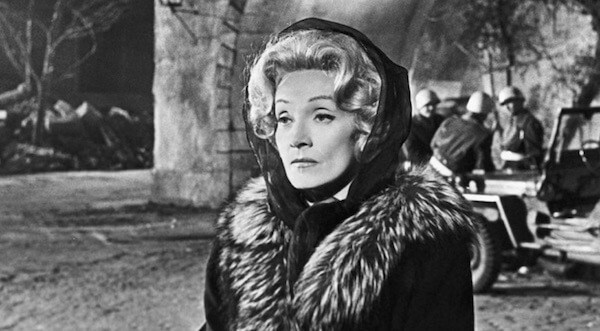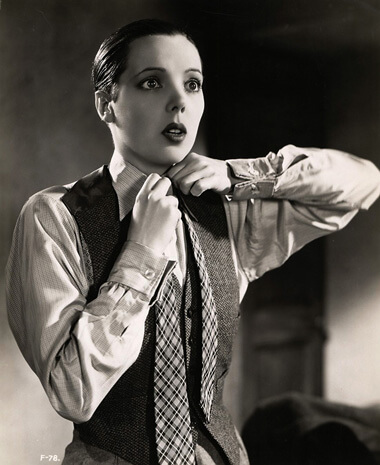BY DAVID NOH | Ingrid Bergman was nothing less than the greatest English-speaking actress in sound films. Having received solid stage and film training and experience in her native Sweden, she came to Hollywood in 1939 and at first struck audiences with her luminously natural, fresh-scrubbed look and unplucked eyebrows, which seemed revolutionary in the age of Dietrich and Crawford.
She then dominated the 1940s with a string of successes in which she proved her magnificent range, despite her accent and big Nordic physicality –– as an uber-sexy Cockney slut and heartbreakingly pathetic victim in “Dr. Jekyll and Mr. Hyde,” Hemingway’s Spanish Maria in “For Whom the Bell Tolls,” the Hoagy Carmichael-loving ideal heroine of the immortal “Casablanca,” a fragile Victorian wife being “Gaslight”ed, a ravishingly funny French Creole New Orleans courtesan in my favorite, “Saratoga Trunk,” and in what many consider Hitchcock’s greatest film, “Notorious.”
Bob Hope would joke that Bergman was in every other movie of the era, but she went on from there, doing experimental Italian films with her second husband, director Roberto Rossellini; a foray with Jean Renoir (“Elena et les homes”); the Oscar-winning “Anastasia”; TV productions of “Hedda Gabler” and “Turn of the Screw”; her hilarious third-Oscar winning satirical Swedish turn in “Murder on the Orient Express”; a dazzling moment as another courtesan, but old and wrecked, in the botched “A Matter of Time”; and finally “A Woman Called Golda [Meir],” her swan song.
Pia Lindström discusses her legendary, luminous mother
Her life was a dazzlingly dramatic and fulfilled movie in itself and Stig Björkman’s “Ingrid Bergman: In Her Own Words” is a quite wonderful documentary –– made with the full cooperation of her surviving four children, Pia Lindström and Roberto, Isabella, and Isotta Ingrid Rossellini –– that easily could have been an hour or so longer than its 114-minute running time. Starting with the actress’ personal journals and letters, and using archival footage as well as family photos and home movies, it delivers a full-scale portrait of a jaw-droppingly gorgeous, sublimely talented woman who confessed to being painfully shy, but with a lion inside her. She also likened herself to a bird of passage, never settling for too long in one place with one man. The fact that all of her children seem fabulously well-adjusted, without a thought among them of writing a “Mommie Dearest” exposé, is a testament to her loving nature and, as all of them state at one time or another, irresistible sense of adventurous fun.
When I interviewed Pia Lindström about this lovely film, I reminded her of the times over the years we’d run into each other at events and invariably wound up talking about her mother. Lindström was always gracious and warmly candid about her, perhaps realizing on some level that Ingrid holds a special place for her fans who, like me, discovered most of her films long after they were released –– as well as for my parents’ generation, by whom she was not only greatly admired, but was in fact the rare movie star who was really loved, like Gary Cooper or Judy Garland, almost a part of the family, especially after “The Bells of St. Mary’s.” There, she gave an iconic performance as the most radiant nun in movie history, an image that would haunt her when she chose to lead her own life. Bergman left Pia and her father to go to Italy and take up movie- and baby-making –– scandalously out of wedlock –– with Rossellini, a decision that shocked America, to the point where she was denounced for immorality on the floor of Congress.
So, it was a special occasion to talk to Lindström formally about her mother, and I opened by asking what prompted the making of the film.
“It was originally Isabella’s idea,” Pia said. “She thought it would be a nice thing to do and it was just a matter of finding the right director. Stig Björkman had done some very good work, and I guess being Swedish helped. He knew some of the background, and we thought he would understand what the project should be. It’s a very nice film, isn’t it? It has a good tone, isn’t judgmental, with no particular point of view. It’s kind to everyone, and that is also why we chose this director. “
I asked Lindström, who along with sister Isabella, has acted herself, how she rated her mother as an actress: “I think she was born to be a film actress. As you probably saw from the film, her father was a photographer and that was the love she saw on the other side of the camera. So she had no fear of the camera and knew she wasn’t playing to it, but to the person behind the camera. Working, smiling, laughing in front of it, the facility for it might have been natural, but it was cultivated from an early age. Plus, what she had, that so many film actors don’t, were the eyes. She could reach emotions and express them through her eyes.
“I think that was the greatest thing she had. Even if someone else was talking, her eyes are really registering something; she’s not just listening politely. That is reacting, not stage acting, which would be that your eyes are all right, but a lot of it is the bend or the shape or the body and your voice. So I would rate her extremely high, and that’s what you responded to, more than her beauty. People said she was beautiful, but there are a lot of beautiful people. They’re lit beautifully; they spend a lot of time of time making people look good, not shooting them with a pimple on their face, anything to not make them normal because the movie style at that time was not to be realistic.”
In moments like her hysteria in “Dr. Jekyll” and “Gaslight,” Bergman brought a raw, near-animal ferocity to the screen unseen in American film up to that time, except maybe as practiced by Bette Davis in her more stylized manner. In “For Whom the Bell Tolls,” her electrifying monologue describing the savage execution of her parents by Franco’s fascists stops your heart.
Lindström agreed, saying, “She had the ability to portray real emotions, cry real tears, or feel horrible. That’s real art, to make the audience feel something and she had that ability. It was a real gift but I think it was part of her early childhood, being around her father and his camera. Her mother had already died when she was a baby and her father not too long after that, so I think she always had kind of a love for her directors, whom she saw as substitute father figures.”
In one case, that love went beyond the platonically paternal: Victor Fleming, who was the first to really unleash her Hollywood talent as Ivy Brown in “Dr. Jekyll,” a character Miriam Hopkins had also essayed brilliantly a decade before, and which doesn’t even exist in Robert Louis Stevenson’s novella.
“Oh, yes!” Lindström said. “They loved each other so much. He also directed her in ‘Joan of Arc.’ She had done the stage play and always wanted to do the film. But there was no blood in it. It looked like a stage play and those were they days when people were first going on location and wanted to show something more gritty. It was a big flop. Fleming spent so much time lighting my mother, I don’t think she ever looked more beautiful, and then he died right after that. It was such a blow and two families were devastated by it. I thought that was a poignant experience for her.”
Lindström herself appeared in the 1948 movie: “I did a crowd scene and watched my mother being dragged off to be burnt. It was great fun being with all the kids, and we didn’t have to go to school. You were on the set, then you had lunch and they tried to make you read something, for schooling. I remember Victor Fleming paid me in a hundred pennies in a big sack. He was a very attractive man, and it was a sad story.”
The documentary touches on the affair with Fleming, but leaves out other rumored dalliances, like those with Gary Cooper and Spencer Tracy (Katharine Hepburn’s niece, Katharine Houghton told me that Bergman was one of the few women that Hepburn was insanely jealous of). When I mentioned to Lindström that her mother almost lived like a man with complete independence, she scoffed, “Wait a minute! Wait a minute! What do you mean, ‘independent?’ She was always married, always had a man taking care of her!
“Like when she was with [war photographer] Robert Capa –– that’s not independence, that just means you believe in what they believed in in the 1960s: free love! She fell in love a lot. That last marriage she had to Lars Schmidt –– they got divorced, but he still took care of her, financially, the business thing, everything! We don’t have a term for this anymore, but her path may have been a little bit freer.”
I asked Lindström how all this free love and life affected her as a child.: “I didn’t know what was going on. It was only much later, when I was grown up, that we talked about it as adults She was open about her life, but not completely. I have children myself, but I’m not completely open with them. We all have things that we keep to ourselves, don’t we? And that’s a good thing! It works better that way, although I’m not sure if it works in every relationship, like with men and men or women with women. They don’t need to know everything you did in the past, do they?
“When my mother was with Rossellini, I didn’t have a second family because she left me and went to Rome, while I lived with my father. I visited her once in London when my father took me there, and I met her again when I was 18. I met her children and they were adorable. And she was adorable. You know actresses –– they’re a lot of fun! They retain the ability to play.”
Does Lindström have a favorite Ingrid Bergman movie?
“I don’t have a favorite one. But one that touches me is “Autumn Sonata.’ It’s her story and Ingmar Bergman’s story. That’s the woman I think of as my mother. In her other movies, which I saw as a child, like ‘Gaslight,’ she is an actress like I saw on the stage, but I like ‘Notorious’ the best and her performance in that very much.
“But the subject of ‘Autumn Sonata’ is so relevant today when you think that if I have a talent or a gift, do I give it to the world or do I stay at home? Ingmar had had a child with Liv Ullmann, so that was his story, too, and they cobbled their stories together. If you travel as an artist and your child has chicken pox, do you go and do your art or do you stay at home and take care of the child? It’s a dilemma, and I think that subject matter is pertinent at al times.”
INGRID BERGMAN: IN HER OWN WORDS | Directed by Stig Björkman | Rialto Pictures | Opens Nov. 13 |Lincoln Plaza Cinema, 1886 Broadway at W. 62nd St. | lincolnplazacinema.com




































